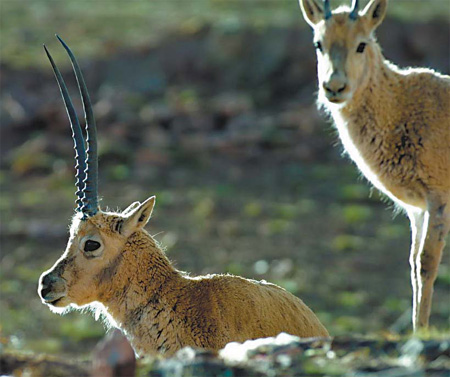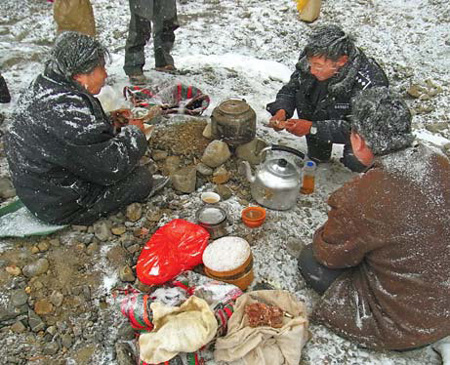Hope springs eternal for chiru
|
The number of Tibetan antelopes has increased significantly in Nagqu, Tibet, thanks to the efforts of local wildlife guardians. Courtesy of WCS |
It's an uphill task to protect the endangered Tibetan antelope, prized for its ultra fine wool, from poachers. But recent efforts are paying off. Yang Guang reports
As the sun goes down over the horizon, a Tibetan antelope collapses from exhaustion after being chased. A poacher on his motorcycle races up, skins her and speeds away. The pregnant antelope slowly regains consciousness and struggles to stand up, but falls to the ground, dead.
Tibetan forest policeman Jigme is shocked and enraged when he hears this confession from a poacher, during an interrogation.
Police eventually confiscate 66 antelope skins from the group of 20 poachers, who are all sentenced to 4-6 years in prison, in accordance with China's Wildlife Protection Law.
All this happened in 2007 but Jigme's anger has still not abated. This was evident as he recalled the story at a ceremony held in Beijing to honor him with the China Border Wildlife Guardian Award, last week, which he accepted on behalf of the Forest Security Bureau of Nagqu prefecture in northern Tibet.
Jigme, which means "the fearless" in the Tibetan language, has been working in Nagqu since graduating from the Nanjing Forest Police College, six years ago. At 27, he is the youngest deputy bureau director in the prefecture.
A native of Shannan prefecture in southern Tibet, he had to adapt to the conditions in Nagqu. "It is very different from Shannan, with much lower temperatures, stronger winds and more barren land," he says.
With an average altitude of 4,500 m above sea level, Nagqu covers 420,000 sq km, over half of which is uninhabited. It is home to more than 100 species of wild animals and the largest concentration of the indigenous Tibetan antelope, or chiru, in the world.
The wool of the antelope, called shahtoosh, is soft, ultra fine, warm and much sought-after. A shahtoosh shawl can fetch thousands of dollars in the international market. Illegal dealers say they collect the wool when the antelope molts, but according to the United States-based Wildlife Conservation Society (WCS), it can only be obtained by killing the animal, as the best wool is found on the animal's underside. It takes the killing of 3-5 antelopes to make a shawl and a pregnant chiru is particularly prized as it can produce more wool. Also, since shooting reportedly ruins the wool, the animals are often beaten to death.
According to George Schaller, chief scientist with WCS, who has been working in the area for 20 years, the antelope's population has dwindled from more than 1 million in the early 1890s to around 70,000 in the mid-1990s, due to rampant poaching.

Jigme's bureau was founded in 1993 to conserve wildlife and enforce the law. But even today it is badly understaffed, with just eight people - five Tibetans and three Han - who are poorly equipped in terms of vehicles and communication devices.
The bureau's case is not unique. Forest security bureaus in the region are understaffed, with just 34 forest officials, which works out at an average of one official in charge of more than 10,000 sq km.
Jigme says each year two large-scale patrols are held - one in May and the other in November, corresponding to the chiru's reproduction and mating seasons respectively - and lasts almost a month.
Regarding the May 2007 patrol, five forestry officials left for the Changtang Nature Reserve, to help Forestry Bureau of the Tibet autonomous region shoot a publicity video on wildlife conservation.
The car broke down halfway and they had to hire five herdsmen, five horses, two motorcycles, and one tractor to proceed. Not long afterwards, the motorcycles and tractor too stopped functioning.
With only five horses to carry all their equipment, they had to drop the less important items one by one, and mark the places where they had buried them, for later retrieval. "We had to be most vigilant about the wild yaks, especially the calves," Jigme says.
It took them a month to finally arrive at the reserve. But its poetic beauty left a deep impression on Jigme. "Standing on top of a hill, I looked down and saw so many animals in the valley: antelopes, wild yaks and brown bears," he says. "It was so beautiful."
For Jigme and his colleagues, enduring the rigors of the wilderness during patrols - such as living on dried meat and instant noodles boiled in melted ice water and spending nights in threadbare tents - is par for the course.
But not all patrols have happy endings. In fact, most don't. Shortly before Jigme began to work in Nagqu prefecture, a fellow policeman died from poachers' gunfire.
Every time the forestry officials set off, Jigme says, the families hold a farewell dinner and present them with hada (a piece of long white gauze that Tibetans give to honored guests for good luck), with a clear understanding that the journey might come to an unwelcome end.
"We face similar situations to those shown in Lu Chuan's film Kekexili: Mountain Patrol; only we are even more poorly equipped," he says.
Jigme's wife works in the local hospital, but his 1-year-old son is under the care of the grandfather at Shannan.
Aside from cracking down on poaching, the forestry officials take advantage of contact with the herdsmen to publicize wildlife conservation.
Hunting is a Tibetan tradition. But now most Tibetans will report to the police if they find evidence of poaching or carcasses in the wilderness; they now frighten off brown bears by setting off firecrackers, instead of using a gun.
When the second phase of the Qinghai-Tibet Railway, Golmud-Lhasa section, which crosses the migration routes of the Tibetan antelope, became operational in July, 2006, many worried that it would affect the habitat of the antelope and other animals.
However, WCS scientist Schaller's observation confirms that the government has been successful in protecting the antelopes; the animals are often seen grazing near the railway tracks.
The number of Tibetan antelope, wild donkey, wild yak and other species in Nagqu has increased significantly, according to Schaller's observation.
Researchers spotted 60,000 Tibetan antelopes in just 20 days, during a survey conducted by Tibet's Forestry Bureau and other conservation and research organizations earlier this winter. The total number is estimated to exceed 100,000.
Also, according to Xie Yan, China Program director with WCS, while antelope in Nagqu would run when people were a kilometer away, now they can get to within 300 m of the animals.
"It is the dream of a wildlife protector to be able to watch a rare wild animal from up close and you can realize this in Nagqu," says Joel Berger, a senior scientist with WCS.
|
Forest policemen have to cope with appalling weather conditions. Kang Aili |
(China Daily 02/01/2010 page22)
















